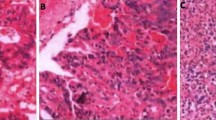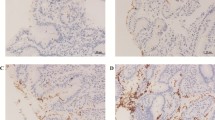Abstracts
Background and Aim
Despite similar incidence of Helicobacter pylori infection, the frequency of gastric cancer is sevenfold higher in Japan than in India. The objective of this work was to define differences in H. pylori-induced gastritis and to identify the bacterial virulence factors involved.
Materials and Methods
We prospectively enrolled 353 consecutive patients who underwent endoscopy and received three gastric biopsies in Tokyo, Japan, and Hyderabad, India. Immunohistochemistry against H. pylori and East Asian CagA and hematoxylin–eosin and Giemsa stain were used to examine gastric mucosal biopsy specimens. Histological scores were assessed in accordance with the updated Sydney System. Subjects with H. pylori infection were matched by age and sex to compare histopathology and bacterial virulence.
Results
Sixty patients infected with H. pylori were prospectively selected. Median histological scores for neutrophil and mononuclear cell infiltration and for atrophy were significantly higher in Japan than in India (neutrophils 4.0 vs 3.0, p < 0.01; mononuclear cells 5.0 vs 4.5, p = 0.03; atrophy 3.0 vs 2.0, p < 0.01, respectively). Scores for H. pylori density and intestinal metaplasia were also higher in Japan, albeit without statistical significance (H. pylori 5.0 vs 3.0, p = 0.08; intestinal metaplasia 0.0 vs 0.0, p = 0.08). Prevalence of East Asian CagA-positive H. pylori was significantly higher in Japan (73.3 vs 0.0 %, p < 0.01).
Conclusion
The significantly higher prevalence of histologically severe gastritis and East Asian CagA in patients from Japan with H. pylori infection may be involved in the pathogenesis of gastric cancer.



Similar content being viewed by others
Abbreviations
- H. pylori :
-
Helicobacter pylori
- CagA:
-
Cytotoxin-associated antigen A
- NCGM:
-
National Center for Global Health and Medicine
- AIG:
-
Asian Institute of Gastroenterology
References
Pisani P, Parkin DM, Bray F, Ferlay J. Erratum: Estimates of the worldwide mortality from 25 cancers in 1990. Int J Cancer. 1999;83:870–873.
Roder DM. The epidemiology of gastric cancer. Gastric Cancer. 2002;5:5–11.
Fock KM, Ang TL. Epidemiology of helicobacter pylori infection and gastric cancer in Asia. J Gastroenterol Hepatol. 2010;25:479–486.
Uemura N, Okamoto S, Yamamoto S, et al. Helicobacter pylori infection and the development of gastric cancer. N Engl J Med. 2001;345:784–789.
Graham DY, Yamaoka Y. Disease-specific helicobacter pylori virulence factors: the unfulfilled promise. Helicobacter. 2000;5: S3–S9; (discussion S27–S31).
Joossens JV, Hill MJ, Elliott P, et al. Dietary salt, nitrate and stomach cancer mortality in 24 countries. European cancer prevention (ECP) and the INTERSALT cooperative research group. Int J Epidemiol. 1996;25:494–504.
Matsuhisa TM, Yamada NY, Kato SK, Matsukura NM. Helicobacter pylori infection, mucosal atrophy and intestinal metaplasia in Asian populations: a comparative study in age-, gender- and endoscopic diagnosis-matched subjects. Helicobacter.. 2003;8:29–35.
Lee I, Lee H, Kim M, et al. Ethnic difference of helicobacter pylori gastritis: Korean and Japanese gastritis is characterized by male- and antrum-predominant acute foveolitis in comparison with American gastritis. World J Gastroenterol. 2005;11:94–98.
Naylor GM, Gotoda T, Dixon M, et al. Why does japan have a high incidence of gastric cancer? Comparison of gastritis between UK and japanese patients. Gut. 2006;55:1545–1552.
Jonaitis L, Ivanauskas A, Janciauskas D, et al. Precancerous gastric conditions in high helicobacter pylori prevalence areas: comparison between eastern European (lithuanian, latvian) and asian (taiwanese) patients. Medicina (Kaunas).. 2007;43:623–629.
Abdullah M, Ohtsuka H, Rani AA, Sato T, Syam AF, Fujino MA. Helicobacter pylori infection and gastropathy: a comparison between Indonesian and Japanese patients. World J Gastroenterol. 2009;15:4928–4931.
Dixon MF, Genta RM, Yardley JH, Correa P. Classification and grading of gastritis. The updated Sydney system. International workshop on the histopathology of gastritis, Houston 1994. Am J Surg Pathol. 1996;20:1161–1181.
Hatakeyama M. Helicobacter pylori and gastric carcinogenesis. J Gastroenterol. 2009;44:239–248.
Uchida T, Kanada R, Tsukamoto Y, et al. Immunohistochemical diagnosis of the cagA-gene genotype of helicobacter pylori with anti-east Asian CagA-specific antibody. Cancer Sci. 2007;98:521–528.
Nguyen LT, Uchida T, Kuroda A, et al. Evaluation of the anti-east Asian CagA-specific antibody for CagA phenotyping. Clin Vaccine Immunol. 2009;16:1687–1692.
Rugge M, Genta RM. Staging and grading of chronic gastritis. Hum Pathol. 2005;36:228–233.
Wong BC, Ching CK, Lam SK, et al. Differential north to south gastric cancer-duodenal ulcer gradient in China. China ulcer study group. J Gastroenterol Hepatol. 1998;13:1050–1057.
Yeomans ND, Naesdal J. Systematic review: ulcer definition in NSAID ulcer prevention trials. Aliment Pharmacol Ther. 2008;27:465–472.
Kimura K, Takemoto T. Endoscopic atrophy border. Endoscopy.. 1969;1:1–3.
Correa P, Haenszel W, Cuello C, Tannenbaum S, Archer M. A model for gastric cancer epidemiology. Lancet. 1975;2:58–60.
Whiting JL, Sigurdsson A, Rowlands DC, Hallissey MT, Fielding JW. The long term results of endoscopic surveillance of premalignant gastric lesions. Gut. 2002;50:378–381.
Matsuhisa T, Matsukura N, Yamada N. Topography of chronic active gastritis in helicobacter pylori-positive Asian populations: age-, gender-, and endoscopic diagnosis-matched study. J Gastroenterol. 2004;39:324–328.
Yamaoka Y. Pathogenesis of helicobacter pylori-related gastroduodenal diseases from molecular epidemiological studies. Gastroenterol Res Pract.. 2012;2012:371503.
Yamaoka Y, Orito E, Mizokami M, et al. Helicobacter pylori in north and South America before columbus. FEBS Lett. 2002;517:180–184.
Yamaoka Y. Mechanisms of disease: Helicobacter pylori virulence factors. Nat Rev Gastroenterol Hepatol.. 2010;7:629–641.
Azuma T. Helicobacter pylori CagA protein variation associated with gastric cancer in Asia. J Gastroenterol. 2004;39:97–103.
Satoh K. Does eradication of helicobacter pylori reverse atrophic gastritis or intestinal metaplasia? Data from japan. Gastroenterol Clin North Am. 2000;29:829–835.
Li GQ, Xia HH, Chen MH, et al. Effects of aspirin on the development of helicobacter pylori-induced gastric inflammation and heterotopic proliferative glands in mongolian gerbils. Helicobacter.. 2008;13:20–29.
Barkin J. The relation between helicobacter pylori and nonsteroidal anti-inflammatory drugs. Am J Med. 1998;105:22S–27S.
Kuipers EJ, Lundell L, Klinkenberg-Knol EC, et al. Atrophic gastritis and helicobacter pylori infection in patients with reflux esophagitis treated with omeprazole or fundoplication. N Engl J Med. 1996;334:1018–1022.
Acknowledgments
This work was supported by a Grant-in-Aid from the Ministry of Health Labor and Welfare of Japan and a Grant-in-Aid from the Ministry of Education, Culture, Sports, Science, and Technology of Japan (271000) and a grant from the National Center for Global Health and Medicine. The funders were not involved in study design, data collection and analysis, decision to publish, or preparation of the manuscript. We thank Hisae Kawashiro, Clinical Research Coordinator, NCGM, Tokyo, Japan, for assistance with data collection. We express our sincere gratitude to Drs Anuradha Sekaran and Mitnala Sasikala, AIG, Hyderabad, India for the pathological specimens and blood samples.
Conflict of interest
None.
Author information
Authors and Affiliations
Corresponding author
Rights and permissions
About this article
Cite this article
Fujiya, K., Nagata, N., Uchida, T. et al. Different Gastric Mucosa and CagA Status of Patients in India and Japan Infected with Helicobacter pylori . Dig Dis Sci 59, 631–637 (2014). https://doi.org/10.1007/s10620-013-2961-x
Received:
Accepted:
Published:
Issue Date:
DOI: https://doi.org/10.1007/s10620-013-2961-x




